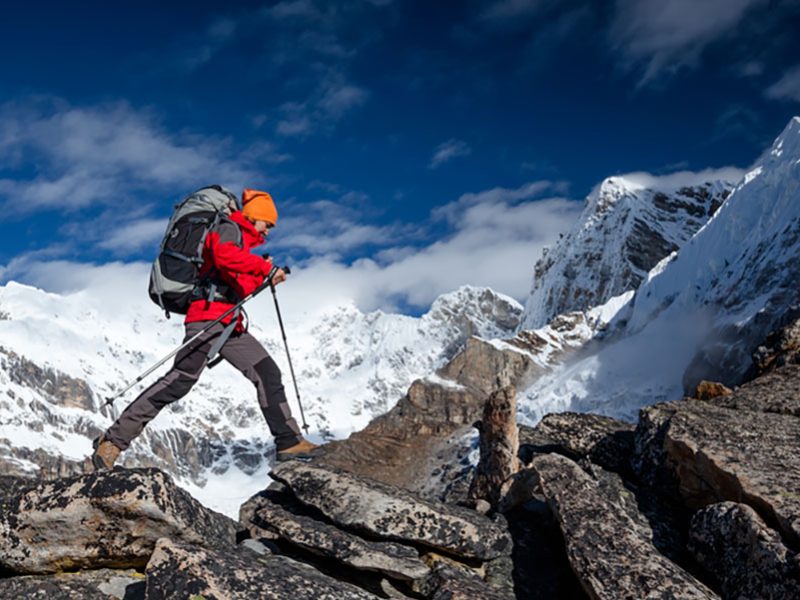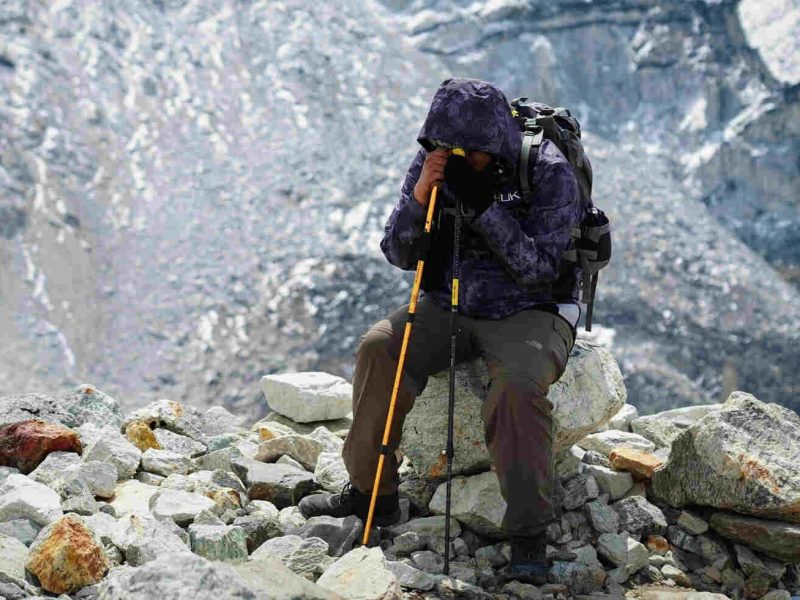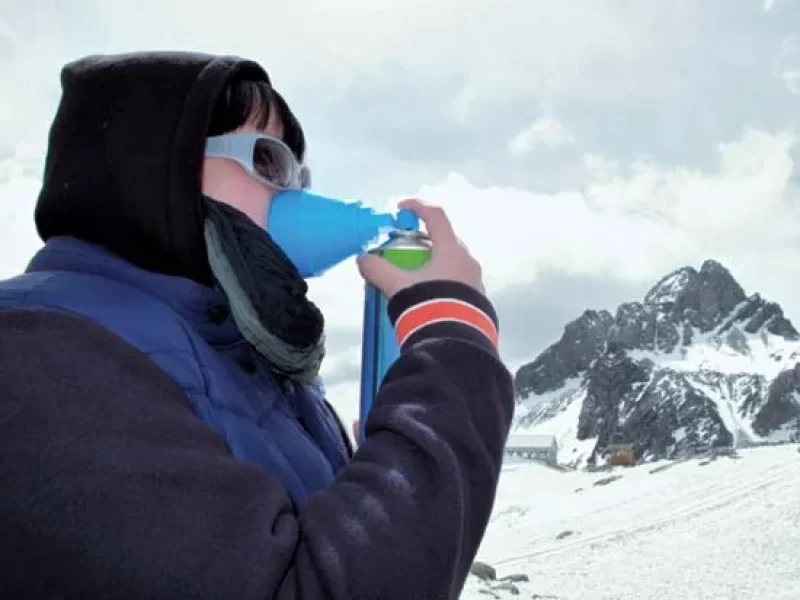Altitude sickness is a condition where the body struggles to adapt to reduced oxygen levels at high altitudes. It is also known as acute mountain sickness (AMS). Main reasons that lead to a mismatch between oxygen supply and demand, affecting various bodily functions appears due to rapid ascent to high elevations without sufficient time for acclimatization.
Common symptoms include headache, nausea, vomiting, fatigue, dizziness, loss of appetite and difficulty sleeping. Altitude sickness can progress to more serious conditions like high-altitude cerebral edema (HACE) or high-altitude pulmonary edema (HAPE) in severe cases.
Regardless of age, gender or fitness level, and its severity varies from person to person, anyone can be affected by AMS. Mild cases can be managed with rest and hydration, while more severe symptoms may require immediate descent to lower altitudes and medical intervention.
Factors Contributing To High-Altitude Sickness
When trekking to high elevations High-altitude sickness (AMS) a serious health issue can occur. Factors contributing to AMS include rapid ascent, elevation, rate of ascension, individual susceptibility, physical fitness, dehydration, sleep quality, alcohol and caffeine consumption and previous AMS experiences.
AMS symptoms may occur due to rapid ascent that can cause a mismatch between oxygen supply and demand. Elevation also plays a significant role in AMS development. The symptoms usually appear at elevations above 2,500 meters and increasing with altitude. Increases in the risk occur due to the rate of ascension, especially above 500 meters per day. Genetics, physiology, and pre-existing medical conditions of a person can be more vulnerable to AMS.
Dehydration can increase the symptoms of AMS but physical fitness can help decrease the risk. Sleep disturbances, alcohol and caffeine consumption and previous AMS experiences can also contribute to AMS.
Preparation Before The Trek
It is important to take several key steps to ensure a safe and enjoyable journey before going on a high-altitude trek. These steps include researching the trekking route, assessing your physical fitness level, scheduling a medical check-up with your healthcare provider, packing and gear, altitude training, purchasing travel insurance, sharing your trekking itinerary with friends and family and training and skills development.

For choosing a suitable trek it is important to research about the terrain , altitude gains and potential challenges. People should focus on cardiovascular exercises, strength training and endurance activities. If needed consult a fitness trainer or healthcare professional.
Your body can adapt to reduced oxygen levels at high elevations if you do altitude training or pre-acclimatization exercises. Travel insurance should cover trekking activities at high altitudes including medical emergencies, evacuation, trip cancellation and lost or stolen gear.
In case of emergencies you should provide emergency contacts that should be shared with friends, family or trusted contacts who can assist. Carry a fully charged mobile phone with emergency contact numbers saved, as well as a backup power source or solar charger. In high-altitude regions training and skills development are essential for a successful trek. It is also important to familiarize oneself with local customs, culture and etiquette.
Acclimatization Strategies During High Altitude Trek
For reducing altitude sickness and ensuring a safe journey, acclimatization during high-altitude treks is very important. Strategies include gradual ascent, rest days, the “climb high, sleep low” technique, maintaining hydration and nutrition, avoiding alcohol and caffeine, taking medications like acetazolamide (Diamox), monitoring symptoms, staying warm and rested, practicing deep breathing, and listening to your body.

In order for the body time to adjust to reduced oxygen levels, gradual ascent must be done. Rest days help the body to adapt to higher altitudes. Prevention of altitude sickness symptoms can be done by avoiding alcohol and caffeine.
Staying warm and rested, practicing deep breathing, and listening to your body can help optimize oxygen intake and minimize cardiovascular strain. Prioritizing health and well-being throughout the journey can lead to a successful and enjoyable high-altitude trek.
Recognizing Symptoms Of AMS While Trekking
A common condition that can be identified during trekking is known as Acute mountain sickness (AMS) . Common symptoms include persistent headaches, nausea and vomiting, dizziness, fatigue, loss of appetite, difficulty sleeping, shortness of breath, increased heart rate, general malaise and cognitive changes.
Due to physical activity or waking in the morning these symptoms can worsen. Dizziness may occur due to changes in altitude that can affect balance and coordination. Despite adequate rest and sleep fatigue can persist. Feelings of weakness or fatigue may occur due to loss of appetite. Fatigue and irritability may occur due to sleep disruptions that can disrupt sleep quality .
Indication of more serious altitude-related illnesses is certain due to the shortness of breath, increased heart rate, general malaise and cognitive changes. It is very important to monitor and respond to these symptoms to prevent further complications.
Treatment Options For AMS
Acute mountain sickness (AMS) is a condition that can be treated by descending to lower altitudes, resting, taking medications, using supplemental oxygen therapy, and using hyperbaric chambers. Symptomatic treatment involves treating individual symptoms with anti-nausea medications or over-the-counter pain relievers.
Severe complications like high-altitude cerebral edema (HACE) or high-altitude pulmonary edema (HAPE) require immediate medical attention and evacuation. AIPRM offers tools to manage AMS symptoms and prevent worsening into more serious illnesses.
Emergency Situation During AMS
Acute mountain sickness (AMS) emergencies require prompt action to ensure the safety and well-being of affected individuals. Emotional support and encouragement should be provided to help alleviate anxiety and stress. Cooperation with medical professionals is essential for further treatment and evacuation.
This includes assessing the situation, stabilizing the patient, administering oxygen, descending to a lower altitude if necessary, monitoring vital signs, initiating evacuation procedures if necessary, providing symptomatic treatment, keeping the individual warm and comfortable, maintaining a calm demeanor and coordinating with medical professionals.
If the individual’s condition worsens or there are signs of more serious altitude-related illnesses, emergency evacuation procedures should be initiated. Medications should be administered as needed to alleviate specific AMS symptoms; warmth and comfort should be provided.
Post-Trek Recovery During High Altitude Trek
Post-trek recovery is crucial for the body to recover and readjust after a high-altitude trek. It involves taking fluids and nutrients, consuming a balanced diet, and allowing rest and relaxation. Engaging in gentle exercises like walking, stretching or yoga can promote blood circulation and flexibility without undue stress.

If returning to lower altitudes, allow the body time to adjust to the increase in oxygen levels. Self-care practices, such as massage therapy, meditation, deep breathing exercises or spending time in nature can help alleviate muscle soreness, reduce stress and enhance relaxation.
Monitoring for acute mountain sickness symptoms, reconnecting with nature, and reflecting on the journey are essential. Planning for future adventures and seeking medical attention if needed can help optimize the body’s natural healing process.
By prioritizing these aspects, the body can support its natural healing process and enjoy the sense of accomplishment and rejuvenation that comes with completing a challenging adventure in the mountains.
Conclusion
In conclusion, trekking in Nepal presents challenges, especially high-altitude sickness. To ensure a safe and enjoyable journey, trekkers must recognize symptoms, implement acclimatization strategies, and be prepared with appropriate precautions. Maintaining open communication with companions, guides, and local authorities is crucial for managing AMS. Despite challenges, the rewards of Nepal’s stunning landscapes, cultural encounters, and personal achievements make the journey worthwhile. By embracing adventure and mindfulness, trekkers can navigate the highs and lows of high-altitude trekking with confidence and resilience.
Frequently Asked Questions (FAQs)
1. What is high-altitude sickness, and how does it occur?
High-altitude sickness, also known as acute mountain sickness (AMS) occurs when the body is unable to adapt to the reduced oxygen levels at high altitudes. As trekkers ascend to higher elevations, the air pressure decreases, leading to lower oxygen levels in the atmosphere. This decrease in oxygen availability can result in symptoms such as headache, nausea, dizziness, and fatigue.
2. What are the early symptoms of high-altitude sickness?
Early symptoms of high-altitude sickness include headache, nausea, dizziness, fatigue, loss of appetite, and difficulty sleeping. These symptoms typically manifest at elevations above 2,500 meters (8,000 feet) and can worsen with further ascent.
3. How can I prevent high-altitude sickness while trekking in Nepal?
Preventing high-altitude sickness involves gradual ascent, proper acclimatization, staying hydrated, maintaining adequate nutrition, avoiding alcohol and caffeine, and listening to your body’s signals. It’s essential to ascend slowly, take rest days for acclimatization, and be prepared with appropriate clothing, gear, and medications.
4. What should I do if I experience symptoms of high-altitude sickness during a trek in Nepal?
If you experience symptoms of high-altitude sickness, such as headache, nausea, or dizziness, it’s crucial to take immediate action. Descend to a lower altitude if possible, rest, hydrate, and monitor your symptoms closely. Consider taking medication such as acetazolamide (Diamox) under the guidance of a healthcare professional.
5. How do I know if I need to descend to a lower altitude due to high-altitude sickness?
If your symptoms of high-altitude sickness worsen or become severe, such as persistent headache, vomiting, confusion, or difficulty breathing, it’s essential to descend to a lower altitude immediately. Ignoring severe symptoms can lead to more serious altitude-related illnesses such as high-altitude cerebral edema (HACE) or high-altitude pulmonary edema (HAPE).

Comment (0)